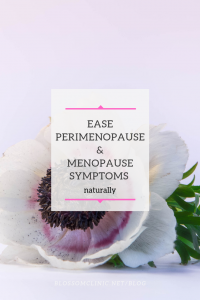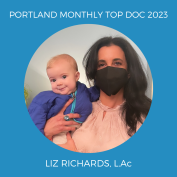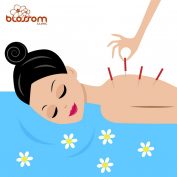Are you sick of waking up in the middle of the drenched in sweat? Or trying to remember where you put your keys? Or snapping at your partner? This is a classic picture of what going into menopause looks like for many women. This transition time is actually called perimenopause.
Perimenopause is when hormones start to shift and you may start to experience unpleasant symptoms like hot flashes, brain fog, and insomnia. The transition usually starts around age 47 and can last 4 to 8 years, and in some, much longer. You’re officially in menopause when 12 months have passed since your last period. This can happen early or late for some women, but the average age is 51 years old.
Hormones shifts are directly related to aging ovaries. Oocytes (eggs) atrophy over time, you stop ovulating and stop producing estrogen and progesterone. It’s important to note, these hormones do much more than help with getting pregnant, they protect you from developing heart disease, diabetes, osteoporosis, and breast cancer. Once you hit menopause, risks of developing these condition increase significantly.
HOW DO I KNOW I’M IN PERIMENOPAUSE?
There are two phases of perimenopause. The first sign that you are experiencing a change is a fluctuation in your cycle length by more than 7 days. Your periods may get closer together, longer, and heavier than before. Late phase is when there are more than 60 days between periods. This is the phase most women experience the worst of the symptoms. Studies have shown that once you enter this phase, you will most likely hit menopause in two years.
You can also test FSH on day 3 of your cycle to see if you are in perimenopause. A normal FSH average is 4 IU. Women in perimenopause will be closer to 14 IU and those closest to menopause will have an FSH of 25 IU or above.
WHAT SYMPTOMS ARE RELATED TO PERIMENOPAUSE OR MENOPAUSE?
Every woman will enter the perimenopause phase differently. Some only notice irregular periods, and boom! No more period. However, your situation is likely a lot different and you’re not alone.
The first stage of symptoms you may experience is related to anovulation and lack of progesterone. This can cause a hyperestrogenic state and lead to symptoms like spotting between periods, heavy and long menses, and an increase in PMS such as bloating, and painful breasts. You may also feel moodier and have a harder time losing weight.
The second stage of symptoms is related to fluctuations in estrogen from too much to too little, leading to hot flashes. They can vary from seconds to lasting an hour. They occur often at night and disturb your sleep. This often leads to depressed mood, brain fog, and low libido. You may start to notice vaginal dryness and pain with intercourse.
WHO SHOULD CONSIDER HORMONE REPLACEMENT THERAPY (HRT):
HRT is not for everyone. There are many natural ways to control symptoms of perimenopause and protect yourself from chronic health conditions. This includes herbs, supplements, exercise and stress management. However, for some, these therapies aren’t enough or the most protective step to take is HRT.
Estrogen and progesterone — which comes in pill, skin patch, gel, cream or spray form — remains the most effective treatment for the relief of troublesome menopausal symptoms.
You may consider HRT if:
- Your symptoms are inhibiting you from enjoying your life and natural therapies aren’t working
- You’re experiencing vaginal dryness, urinary tract infections, and/or painful intercourse
- Your estrogen is in the menopausal range before the age of 51
- You’re taking birth control pills or have within the past 5 years
- Have bone loss and aren’t benefiting from other treatments
WHAT TO EXPECT WITH HORMONE REPLACEMENT THERAPY
Micronized progesterone taken at night before bed is a typical first step to treating perimenopausal symptoms, especially in the earlier stage. This amazing hormone has been shown to help with sleep, reduce anxiety, clear brain fog and more.
The next step in treating hot flashes, after natural therapies have been exhausted or if indicated (i.e. early menopause), is treating with bioidentical estrogen. A common choice is starting with the estradiol transdermal patch. It’s recommended to start at the lowest dose and work up to the lowest effective dose. The transdermal patch has been vetted for safety and risk for clotting is low. Keep in mind, if you have a history of heart disease, stroke or DVT, an estrogen replacement is not recommended.
Lastly, many women only experience vaginal dryness, pain with intercourse, and/or urinary tract infections. The vaginal tissue is sensitive to estriol, a specific type of estrogen. When estriol is low, the vaginal tissue starts to atrophy and dry up. In this case, it is recommended to use a vaginal estriol cream 2 to 3 times a week. This treatment works great for most women!
 OTHER TREATMENTS OPTIONS TO CONSIDER
OTHER TREATMENTS OPTIONS TO CONSIDER
Ovaries are intricately connected to the thyroid and the adrenal glands. When they are also out of balance, it can make your symptoms much worse. It’s important to check the health of the thyroid and the adrenals and treat if necessary. Balancing cortisol levels (stress hormone) can help reduce symptoms. This can be done with a low-sugar diet, mindfulness, and exercise. However, sometimes a much stronger treatment is needed to rebalance the thyroid and adrenals, and a specific supplement protocol is recommended.
For many women, a slight hormonal imbalance can be remedied with natural therapies. For example, common herbal remedies for hot flashes include black cohosh, red clover, and dong quai. Supplementation includes maca and soy isoflavones. The homeopathic Sepia has also shown to improve hot flashes. And one study found that eating 1 to 2 tablespoons of ground flaxseeds a day reduced hot flash symptoms on half!
IN SUMMARY
Transitioning into menopause doesn’t have to be an uphill battle for years! If you are starting to experience symptoms like depression, insomnia, hot flashes, and brain fog, you’re not alone. These symptoms are very common and there is a root cause for why they’re happening.
Low progesterone and fluctuating estrogen levels can cause all sorts of grief. Hormone replacement therapy can be a very beneficial and effective therapy for those suffering. In addition to hormone therapy, lifestyle and nutritional treatments can also be extremely helpful in seeing the results you desire.
The first step to knowing if this is the right approach for you is to see your naturopathic doctor and get your hormones tested!











 Dr. Haylee Nye is Blossom Clinic’s Naturopathic Doctor. She’s in the office on Tuesdays and Fridays. You can
Dr. Haylee Nye is Blossom Clinic’s Naturopathic Doctor. She’s in the office on Tuesdays and Fridays. You can